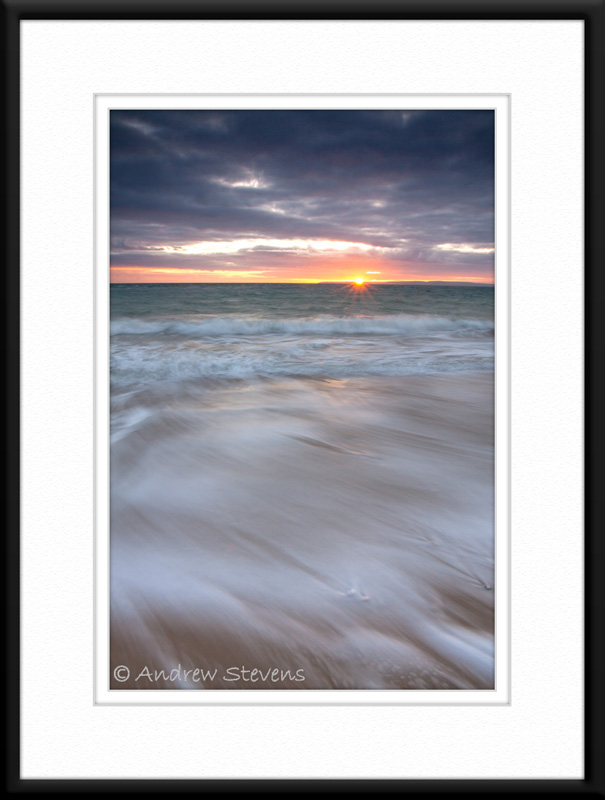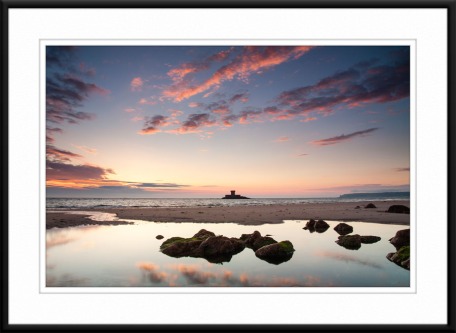It's quite apt that I should choose this image for my next post as I'm typing in the height of pantomime season - but more of that later!
While landscape photography is a solitary pursuit in the main, it's always nice to head out for a shoot with friends. 2013 seems to have been a hectic year for myself and my usual photography buddies and we haven't had many joint outings this year - in fact, we haven't had that many solo outings either! Guess what one of my New Year Resolutions is?!
Now, to some of my non-photographic friends this seems an alien concept. They seem to think that I'm colluding with "the enemy" and don't understand why we would want to venture out together when we're all vying to make the final step from semi to full-time pro photographer. But, put three of us in a line with tripods virtually touching and you'll still see three quite different resulting images as we all impose our own style. That always sounds quite grand, and almost pretentious, to me, but it's true, we would all put a very different spin on the same location and moment in time. For example, one friend would look for the classic composition hidden in the scene, another would massively exaggerate the perspective and aim to distort time while I would probably shoot vertically and emphasise the foreground so you would almost feel your toes at the base of the frame.
Also the fact that I run workshops through the year teaching other people how to take better photos makes them think I'm training up the competition but then I'm fully aware that photography needs a lot of thought and input to make a success of it, and an afternoon or two of training, even with the best pro in the world, will only make you a more thoughtful and considered photographer and not an overnight professional.
The part that always makes me chuckle though is how secretive people will be about locations. If you look at my followers and friends on Twitter, Flickr and Facebook, the majority are photographers. No surprise really, but what does amuse me is a nice image pops up online and usually one of the first three questions is "where is this" which is usually followed by some squirming and question avoidance by the captor of the image as they try not to give the location away. Personally, I'm not that bothered about revealing locations. I started making a lot of images at one particular location in the New Forest and couldn't help but notice the plethora of other images of the same venue that started coming online not long after. Were these new images down to me? The first four visits to this particular location I was on my own all morning; the latest visit I was in the presence of about eight photographers all hustling and bustling to get "the angle". I just grinned, bade them all a good morning and carried on to see what I could conjure up around the next bend in the track. Now, this rise in popularity could partly be down to me, it may not, but if I was really worried about revealing the location I wouldn't have used the word "Mogshade" in any of the image titles from my first shoot!
Which brings me back to me featured image, "A Moment Of Colour" - and before you ask, it's near Ellingham, just off the A31 running though the heart of the New Forest. As I mentioned before, a friend is an exaggerator of perspective and stretcher of time, and he had seen an image of mine of a dead tree with a lovely shape. This dead tree is also all on its own in a great big clearing, so quite easy to isolate. We decided to visit the venue together a) because we hadn't seen each other for ages and b) so I could show him where the tree is.
With busy schedules, we finally fitted a morning in and arrived in plenty of time before sunrise. Unfortunately, the forecast appeared to be letting us down and the promised light cloud that could light up with the rising sun was quite thick and grey. Undeterred, we threw bags on our backs, switched on headlamps and headed off into the forest.
Once at the dead tree we recce'd our options and consulted the Photographer's Ephemeris to make sure we were pointing in the right direction and how long we had before sunrise etc. The sky seemed even greyer, and a colourful sunrise was not going to happen so we went off in search of other possibilities around us. While my friend kept going back to the dead tree to try different angles and perspectives, I ventured off in other directions looking for other trees and subjects that might be useful on other days in better conditions.
As I turned a corner and headed off in a new direction, I saw a patch of blue had appeared in the sky - at last! The clouds were moving quite nicely, and the patch of blue was drifting along almost teasing me. I needed a composition and quickly!
As I turned to head back to my gear, I spotted the Scott's Pine pictured here and liked the colourful foreground so started looking for angles and composition options that I might be able to use. Looking around, I found the almost pyramid shaped patch of more orange coloured heather, which I thought could be used as foreground interest with the angled edges acting as lead-in lines to draw the viewer up and into the image.
So...
Foreground? Check.
Distant nicely shaped tree? Check.
No discarded crisp packets or empty Coke cans? Check.
Blue sky / white cloud combo? No, not yet.
Turning back to where the blue patch had been, I caught sight of my buddy again, this time lying prone in the grass using a telephoto lens to presumably shorten perspective and isolate the dead tree more from the distant backdrop. Thankfully, my patch of blue was getting bigger and still heading in the right direction.
The foreground / sky lighting difference was negligible due to the grey blanket, but I opted for my 0.6 ND Grad filter in the knowledge that the patch of blue would make a bigger difference, and I wanted to enhance the foreground colour. To minimise movement in the image, I opened my aperture a full stop to halve the suggested shutter speed and I was ready to shoot. The blue patch passed behind my chosen tree - click - I had an image. I tried another composition, but the blue had already passed by and the sky was returning to grey.
From spotting the blue patch to capturing the image had probably been no more than two minutes - and a good reminder why I teach the importance of knowing your camera inside out. I instinctively know which dials to turn to change settings so I didn't need to take my eye from the viewfinder in case I missed the "moment".
Meeting up with my photographic buddy again, he was completely oblivious to the colour with only mono images on his memory card and was wondering where I'd got the colour from. As I said earlier, you can take multiple photographers to the same location but they'll come away with quite different images!
Exposure information: 1/6 sec @ f/8, ISO100
Filters used: 0.6 / 2-stop Neutral Density Graduated Filter.
Post processing: RAW file processed in Lightroom with small Contrast boost.
Prints of my images are available from my website.
All images are protected by Copyright Laws for Andrew Stevens Photography.






